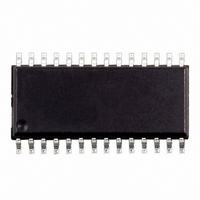L6712ADTR STMicroelectronics, L6712ADTR Datasheet - Page 6

L6712ADTR
Manufacturer Part Number
L6712ADTR
Description
IC CTRLR DC/DC 2PH SYNC 28SOIC
Manufacturer
STMicroelectronics
Type
Step-Down (Buck)r
Datasheet
1.L6712AQTR.pdf
(29 pages)
Specifications of L6712ADTR
Internal Switch(s)
No
Synchronous Rectifier
Yes
Number Of Outputs
2
Voltage - Output
0.9 ~ 3.3 V
Current - Output
2A
Frequency - Switching
150kHz
Voltage - Input
12V
Operating Temperature
0°C ~ 70°C
Mounting Type
Surface Mount
Package / Case
28-SOIC (7.5mm Width)
Power - Output
2W
Operating Temperature Range
- 40 C to + 125 C
Mounting Style
SMD/SMT
Lead Free Status / RoHS Status
Contains lead / RoHS non-compliant
Other names
497-4218-2
L6712A L6712
Table 6. Pin Function (continued)
6/29
SO
10
11
12
13
14
15
16
17
18
19
N. (*)
VFQFPN
11
12
13
14
15
16
18
20
21
9
OSC/INH
REF_IN /
PGNDS1
PGNDS2
DROOP
ISEN1
ISEN2
FAULT
Name
VSEN
OUT
FBG
FBR
A current proportional to the sum of the current sensed in both channel is
sourced from this pin (50µA at full load, 70µA at the Constant Current threshold).
Short to FB to implement the Droop effect: the resistor connected between FB
and VSEN (or the regulated output) allows programming the droop effect.
Otherwise, connect to GND directly or through a resistor (43kΩ max) and filter
with 1nF capacitor. In this last case, current information can be used for other
purposes.
Reference input/output. Filter vs. GND with 1nF ceramic capacitor (a total of
100nF capacitor is allowed).
It reproduces the reference used for the regulation following VID code: when
VID=111, the reference for the regulation must be connected on this pin.
References ranging from 0.800V up to 3.300V can be accepted.
Connected to the output voltage it is able to manage Over & Under-voltage
conditions and the PGOOD signal. It is internally connected with the output of the
Remote Sense Amplifier for Remote Sense of the regulated voltage.
Connecting 1nF capacitor max vs. GND can help in reducing noise injection at
this pin.
If no Remote Sense is implemented, connect it directly to the regulated voltage in
order to manage OVP, UVP and PGOOD.
Channel 1 current sense pin. The output current may be sensed across a sense
resistor or across the low-side mosfet R
low-side mosfet drain or to the sense resistor through a resistor Rg.
The net connecting the pin to the sense point must be routed as close as
possible to the PGNDS net in order to couple in common mode any picked-up
noise.
Channel 1 Power Ground sense pin. The net connecting the pin to the sense
point must be routed as close as possible to the ISEN1 net in order to couple in
common mode any picked-up noise.
Channel 2 Power Ground sense pin. The net connecting the pin to the sense
point must be routed as close as possible to the ISEN2 net in order to couple in
common mode any picked-up noise.
Channel 2 current sense pin. The output current may be sensed across a sense
resistor or across the low-side mosfet R
low-side mosfet drain or to the sense resistor through a resistor Rg.
The net connecting the pin to the sense point must be routed as close as
possible to the PGNDS net in order to couple in common mode any picked-up
noise.
Oscillator pin.
It allows programming the switching frequency of each channel: the equivalent
switching frequency at the load side results in being doubled.
Internally fixed at 1.24V, the frequency is varied proportionally to the current sunk
(forced) from (into) the pin with an internal gain of 6kHz/µA (See relevant section
for details). If the pin is not connected, the switching frequency is 150kHz for
each channel (300kHz on the load).
The pin is forced high (5V Typ.) when an Over Voltage is detected; to recover
from this condition, cycle VCC.
Forcing the pin to a voltage lower than 0.6V, the device stops operation and
enters the inhibit state.
Remote sense amplifier inverting input. It has to be connected to the negative
side of the load to perform programmable remote sensing through apposite
resistors (see relative section).
Remote sense amplifier non-inverting input. It has to be connected to the positive
side of the load to perform programmable remote sensing through apposite
resistors (see relative section).
Description
dsON.
dsON.
This pin has to be connected to the
This pin has to be connected to the












